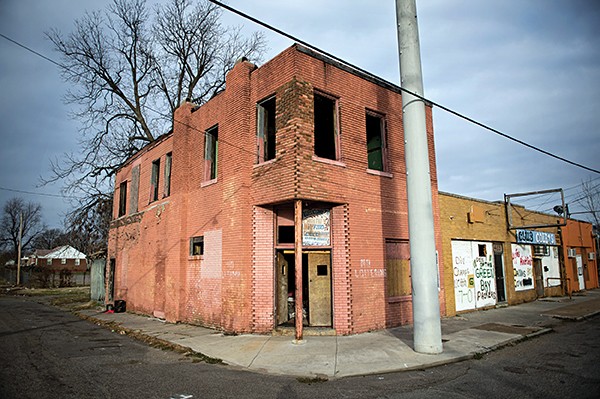As the revival of a handful of high-profile formerly blighted properties — the Crosstown building, the Chisca Hotel — is underway, there are still thousands of rundown homes, long-vacant apartment buildings, and abandoned storefronts scattered across the city.
The problem may seem massive and unmanageable, but as of this month, the city now has a roadmap of sorts for getting a handle on the blight problem. The Memphis Blight Elimination Charter, developed by a team from the public and private sector and coordinated by Neighborhood Preservation, Inc., sets up a framework for tackling the issue and paves the way for the development of a blight elimination team and action plan.
Blight fighter Brandon Gaitor took a few minutes to discuss the city’s problem, the charter, and what comes next.
— Bianca Phillips
 Brandon Dill
Brandon Dill
Brandon Gaitor
Flyer: The charter’s intro says Memphis is facing a “blight epidemic.” How bad is it?
Brandon Gaitor: Blighted property in Memphis is currently worse than it has ever been. Both the amount of blight and the scale of its negative impact on quality of life has truly challenged Memphis. Frayser, Orange Mound, Whitehaven, and the Klondike/Smokey City area stick out in my mind as parts of our city that have the greatest challenge. These areas are predominantly African-American neighborhoods that are also challenged by a slew of other social issues like poverty, crime, divestment, and challenges associated with inadequate public transportation and access to fresh produce.
Why do we need a charter to help us deal with the blight problem?
Local government, the private sector, civic groups, nonprofit, and residents are realizing that Memphis’ challenge with blighted property is far too great to fix without coordinated collaboration. This means organizations sharing information that impacts us all. This means aggregating resources — human and capital — in a way that scales the impact of our efforts.
If blight had a motto it would be “divide and conquer.” As long as we are disjointed in our efforts, no progress will be made. This charter is our moral compass in blight elimination efforts in Memphis. But admittedly this is only the first step. Mere words can’t revitalize our communities. It will take years of ongoing efforts to implement the goals and principles of the charter. The second step in this process is finalizing an action plan that assigns specific tasks to various groups in pursuit of manifesting the ideals on paper into an increase in Memphis’ quality of life.
What are some examples of strategies that haven’t worked?
Underfunded code enforcement, disjointed organizations competing for the same resources for the same areas, unorganized neighborhood revitalization, an outdated tax foreclosure protocol and tax sale system that is too often exploited by out-of-town investors. We have to create incentives that allow good property owners to excel and bad property owners to fail.
 Brandon Dill
Brandon Dill
Blighted property in South Memphis
What can residents do when dealing with a blighted property in their area?
The best thing that residents can do is organize. Take advantage of the Neighborhood Preservation Act. Take advantage of the Shelby County tax sale and the overstock of vacant land and property owned by Shelby County. Get to know the designated code enforcement field officer for your neighborhood and coordinate with them to bring blighted properties into compliance with city code.
Is Memphis a pioneer in creating a charter for dealing with blight?
Memphis is the first and only city to produce a charter of this scale, but cities like Flint, Michigan, and Cleveland, Ohio, have adopted blight-elimination frameworks or other collaborative efforts that have successfully seen an impact beyond what they could do in organizational silos.
When will the blight elimination team be organized? What would be their primary duty?
The blight elimination team will be the topic of discussion at the steering committee’s April meeting. I believe that the team will be finalized within the next few months. Their primary duty would be to implement and create the action plan, which gives specific tasks for various organizations with benchmarks and metrics to measure our impact.
Will they start by surveying all the blight in Memphis?
That blight survey has already been done thanks to the Bluff City Snapshot. Every parcel in the city of Memphis has been surveyed to assess property condition, litter, occupancy/vacancy, etc. This is a huge resource for all blight fighting efforts.